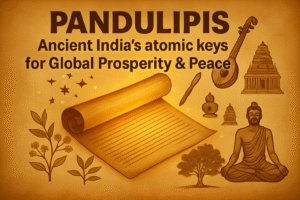Are you ready for Shani Dev’s final verdict?
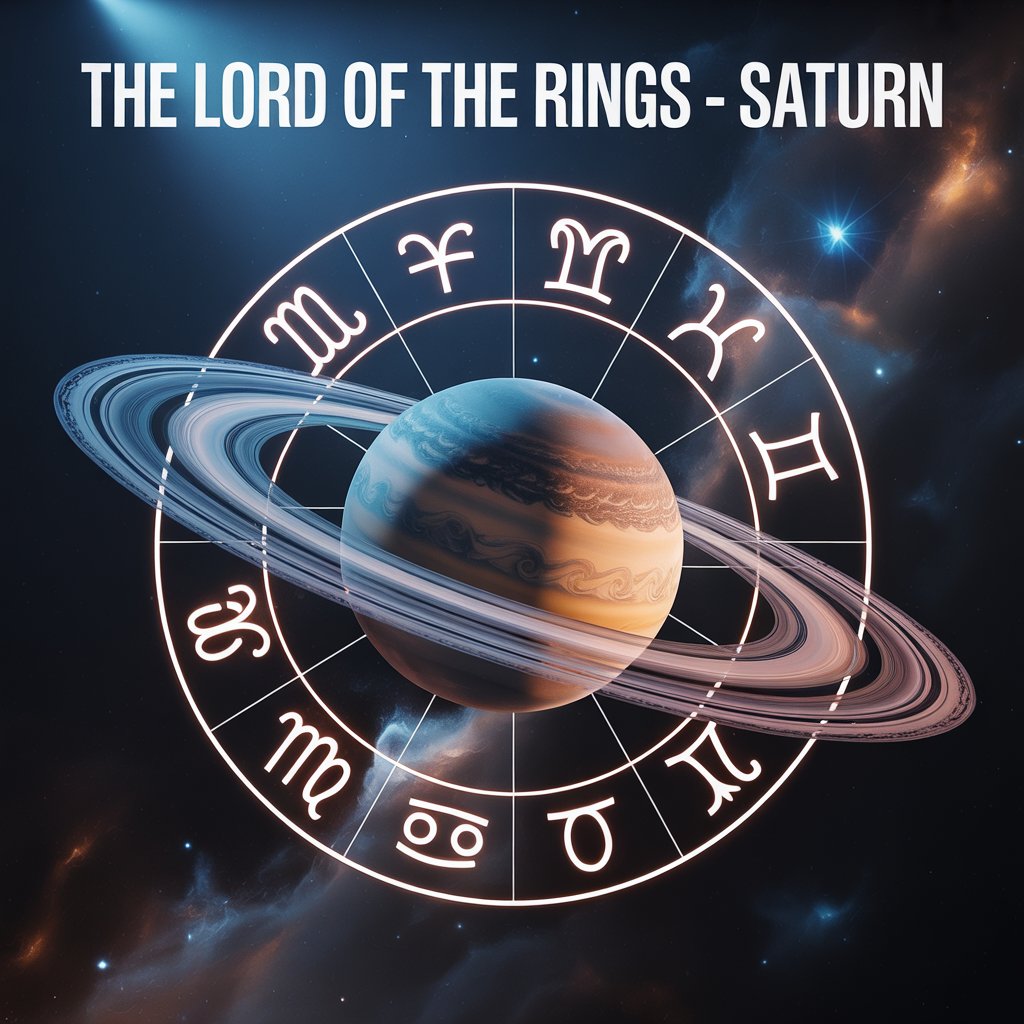
In 2019, a team of astrophysicists at Cambridge University made a startling discovery while cross-referencing ancient Sanskrit astronomical texts with data from NASA’s Cassini mission. The calculations didn’t just match; they were more accurate than 18th-century European astronomy. What secret did ancient Indian scholars possess that allowed them to map Saturn’s orbit with space-age precision, using nothing but palm leaves and mathematical poetry? The answer will challenge everything you think you know about the history of human knowledge.
Welcome to the most mind-bending convergence story of our time.
Picture this: You’re scrolling through NASA’s latest Saturn data when something stops you cold. The numbers look familiar – Eerily familiar. That 29.37-year orbital period? The ancient Vedic texts called it first. Saturn’s role as the cosmic timekeeper? Indian scriptures mapped it millennia ago with jaw-dropping precision.
The Planet That Terrifies and Mesmerizes
Saturn doesn’t just orbit, it lurks. No celestial body evokes such astounding fear and fascination as this ringed giant that the ancients named Shanni Dev. For nearly three decades, this cosmic judge traces its celestial path with the patience of eternity itself, dispensing karmic justice with astronomical precision.
But here’s where it gets spine-tingling: How did sages armed with nothing but naked eyes and ancient wisdom nail Saturn’s secrets with such laser-sharp accuracy?
In the annals of human achievement, few discoveries rival the moment when ancient Sanskrit texts revealed astronomical precision that would make modern space agencies pause in wonder. Hidden within sacred verses and mathematical treatises lies a revelation that challenges everything we thought we knew about the progression of scientific knowledge: the ancient Indians didn’t just observe Saturn, they tracked it with satellite-grade accuracy, millennia before the first telescope were ever conceived.
The Vedic GPS: Mapping Saturn Without Telescopes
Long before GPS satellites orbited Earth or space probes journeyed to the outer planets, Vedic astronomers had already cracked the code of Shanaishchara literally “the slow crawler “with mathematical precision that defies conventional understanding of ancient capabilities. The Surya Siddhanta, composed around the 4th-6th centuries CE but containing knowledge that may stretch back millennia, presents Saturn’s orbital calculations with an accuracy that rivals modern measurements.
Consider this astronomical feat: without a single optical instrument, these ancient observers determined Saturn’s orbital period as approximately 29-30 years. Modern astronomy, armed with centuries of telescopic observation and space-based measurements, confirms this as 29.37 Earth years, a margin of error so small it suggests methodologies that transcend mere naked-eye observation.
The Brihat Samhita of Varahamihira goes even further, describing Saturn’s movement through the zodiac with clockwork precision: 2.5 years per sign, completing its full celestial circuit in what the text calls “one generation of human karma.” This isn’t poetic metaphor its mathematical reality encoded in spiritual language.
The Celestial Chronometer: How Ancient Seers Decoded Time
The Sanskrit astronomical texts reveal Saturn as far more than a wandering star, they present it as the cosmos’s master timekeeper, the Kala Purusha or embodiment of time itself. In the Vishnu Purana, Saturn emerges as the divine accountant who measures not just celestial cycles but the moral rhythms of existence: “Shani karmadhipati”, Saturn governs karma, ensuring that every action ripples through time with mathematical certainty.
But how did they achieve such precision? The Vedic method appears to have integrated multiple observational techniques that modern science is only beginning to appreciate. The ancient astronomers tracked Saturn’s position against the fixed stars, noted its retrograde motions, and calculated its synodic periods with remarkable accuracy. The Panchasiddhantika describes a sophisticated system of celestial coordinates that functioned like an early GPS, mapping Saturn’s location with precision that wouldn’t be matched in the West until the Renaissance.
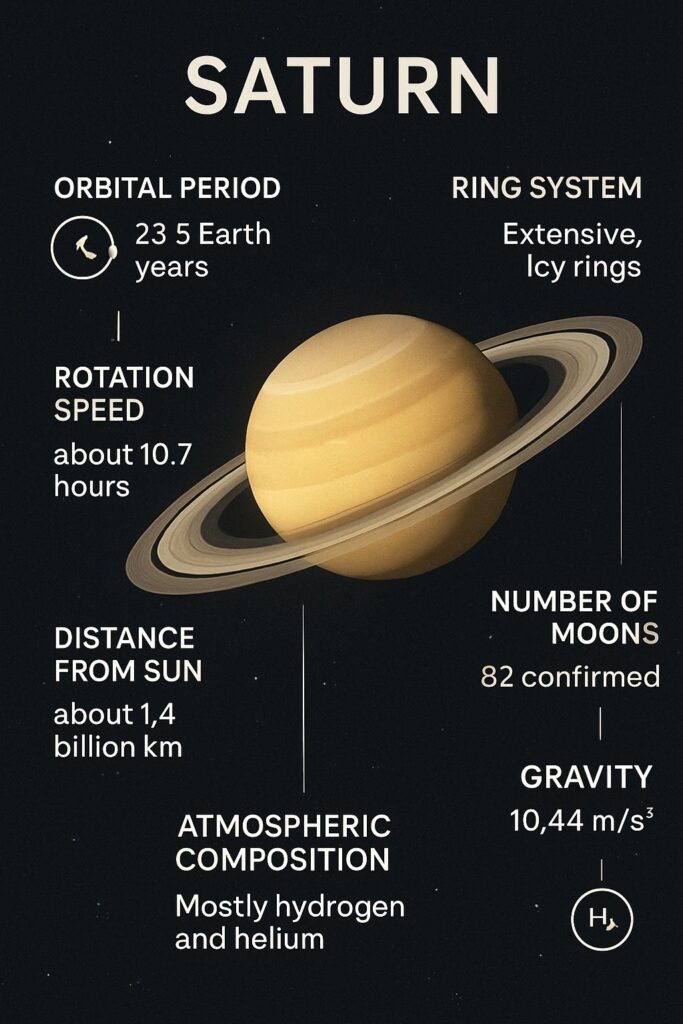
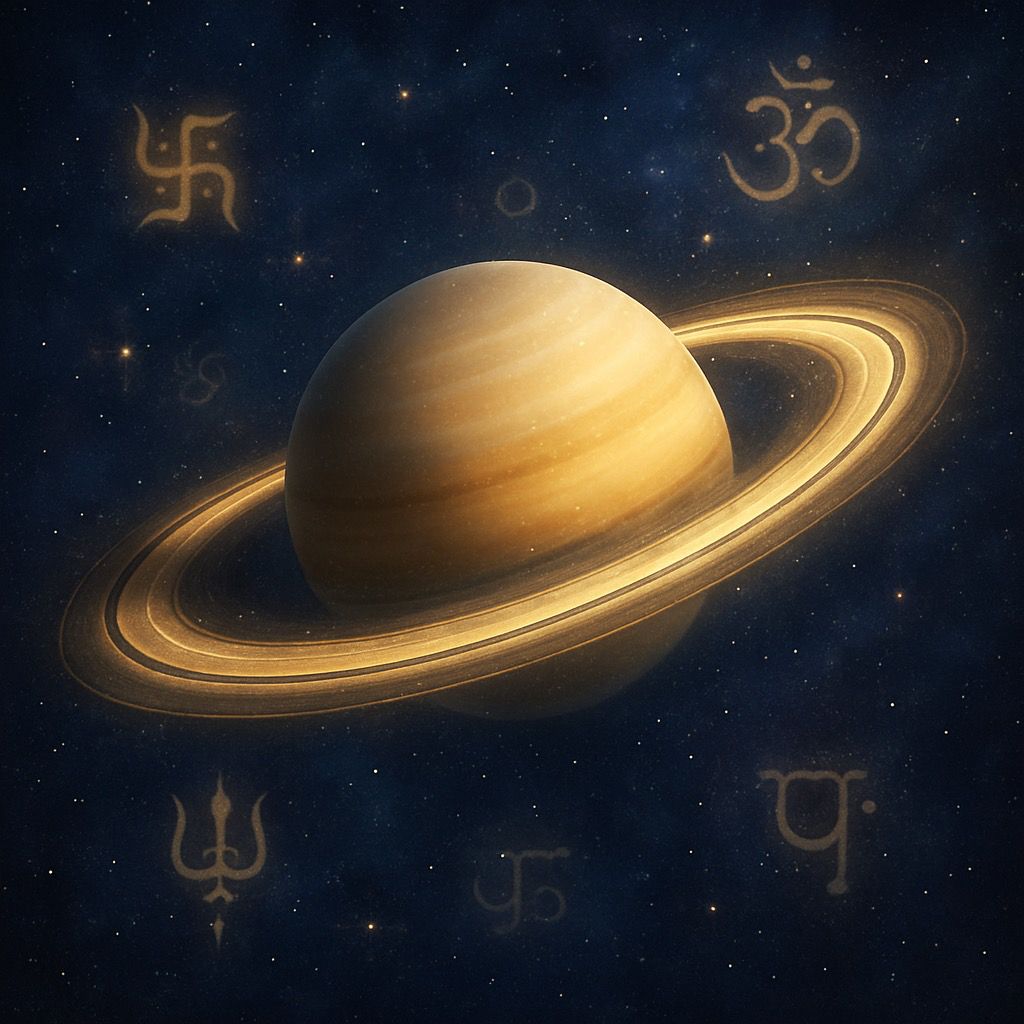
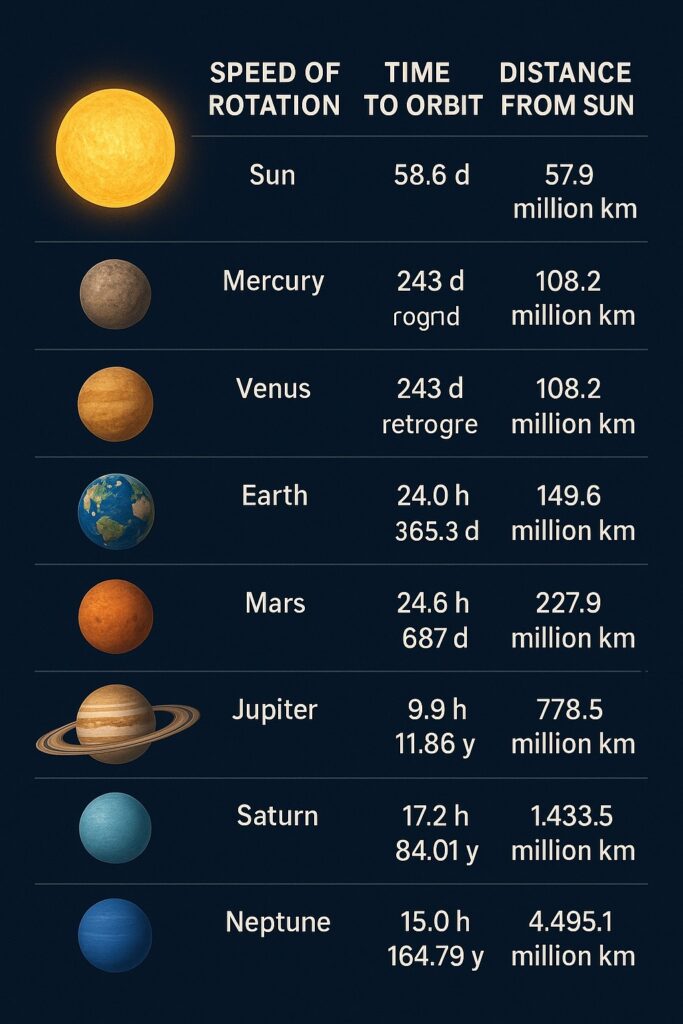
When Two Worlds Collide: The Breathtaking Convergence
When NASA’s Cassini spacecraft began its 13 year exploration of Saturn in 2004, it unveiled a world of staggering complexity that validated many ancient insights while revealing new layers of cosmic architecture. Saturn rotates in just 10 hours and 33 minutes, creating such centrifugal force that it bulges dramatically at its equator, making it the most oblate planet in our solar system.
The spacecraft revealed over 80 moons dancing in gravitational harmony, intricate ring systems containing billions of particles, and magnetic fields that extend far into space. Saturn’s gravitational influence helps stabilize the entire outer solar system, shepherding asteroids and comets into predictable patterns. Its rings, composed primarily of water ice and rock debris, create a dynamic system where gravitational resonances maintain gaps and divisions with clockwork precision.
Perhaps most remarkably, Cassini confirmed that Saturn’s gravitational field plays a crucial role in cosmic timekeeping, its orbital resonances create temporal patterns that ripple throughout the solar system, influencing everything from asteroid trajectories to the stability of planetary orbits.
The Convergence: When Sanskrit Meets Spacecraft Data
The most profound revelation emerges when we overlay the Cassini mission’s findings with ancient Sanskrit calculations. Both traditions recognize Saturn as an agent of cosmic order, modern science through gravitational mechanics, ancient wisdom through karmic law. The convergence is so precise it suggests that the Vedic astronomers accessed information about celestial mechanics through methods that contemporary science doesn’t fully understand.
The ancient insight that Saturn governs time finds its scientific validation in how the planet’s orbital resonances create generational cycles in human experience while simultaneously maintaining cosmic architectural stability over geological timescales. When the Garuda Purana describes Saturn’s influence on human longevity and the aging process, it anticipates areas where modern chronobiology is discovering potential planetary influences on biological systems.
The Revolution in Understanding
This isn’t just Saturn’s story; it’s humanity’s awakening to the possibility that ancient wisdom and modern science aren’t competing worldviews but complementary approaches to cosmic truth.
As Saturn continues its deliberate 9.68 km/s journey through space, completing its 10-hour 33-minute rotations while governing the 29.37-year cycles that shape both solar systems and human destinies, it challenges us to expand our definition of knowledge itself.
Beyond Observation: The Technology of Consciousness
The Sanskrit satellite tracking system appears to have employed what we might call “consciousness technology”, using expanded awareness as an instrument for cosmic exploration. The meditative traditions described in texts like the Yoga Vashishtha developed sophisticated techniques for transcending ordinary sensory limitations, potentially accessing direct perception of celestial mechanics.
The Vishnu Purana principle “Yad pinde tad brahmande”, as in the microcosm, so in the macrocosm, suggests that cosmic patterns are accessible through inner observation. This methodology treats consciousness not as separate from the cosmos, but as an integral sensing system capable of detecting patterns that span from planetary orbits to psychological rhythms.
Modern quantum physics hints at similar possibilities through observer effect and quantum entanglement, suggesting that consciousness and cosmos may be more intimately connected than classical physics assumed.
The Sanskrit Algorithm: Decoding Ancient Methodology
Analysis of Sanskrit astronomical texts reveals a systematic approach that functioned like an ancient algorithm for celestial tracking. The Vedic astronomers created sophisticated mathematical models that integrated:
- Cyclical calculations based on multiple overlapping time periods
- Positional astronomy using sophisticated coordinate systems
- Harmonic analysis of planetary relationships and resonances
- Statistical refinement through generational observation cycles
The Siddhanta Shiromani of Bhaskara II demonstrates mathematical techniques for calculating planetary positions that wouldn’t appear in European astronomy for another 500 years. These weren’t approximations, they were precise computational methods encoded in Sanskrit verse for easy memorization and transmission.
Implications: Rewriting the History of Human Knowledge
The Sanskrit satellite tracking phenomenon forces us to reconsider our assumptions about the linear progression of scientific knowledge. If ancient observers could achieve space-age precision without modern instruments, what other cosmic insights might traditional knowledge systems contain?
The convergence suggests that reality operates simultaneously on multiple levels mechanical and meaningful, gravitational and karmic, measurable and mysterious. Saturn’s role as both celestial timekeeper and karmic accountant may not be metaphorical thinking, but recognition of deep patterns that connect planetary mechanics to consciousness rhythms.
The Cosmic Code Cracked
Shanaishchara stands as testament to humanity’s ancient capacity for cosmic comprehension that transcended the limitations of available technology. The Sanskrit satellite tracker didn’t just map Saturn’s orbit, it decoded the deeper algorithms that govern time, karma, and cosmic order.
As we continue exploring space with increasingly sophisticated technology, the ancient Sanskrit calculations remind us that the universe may be not only more complex than we imagine, but more accessible to consciousness than we currently believe. In decoding Shanaishchara, our ancestors may have cracked a cosmic code that reveals the cosmos as both mechanical system and conscious intelligence, a discovery that could revolutionize our understanding of both space exploration and human potential.
The slow crawler continues its ancient dance, carrying within its rings and moons the secret of how consciousness and cosmos collaborate in the eternal quest for truth. The real question isn’t whether ancient Vedic astronomers or modern NASA scientists got Saturn “right.” The question is: What other cosmic mysteries are waiting for us to recognize that the universe might be far more interconnected, and far more meaningful, than we ever dared imagine?
Saturn doesn’t just rule the rings; it rules the intersection where mathematical precision meets spiritual wisdom, where the cosmos reveals that some truths are so fundamental they echo across millennia, waiting for humanity to finally hear their cosmic symphony.



